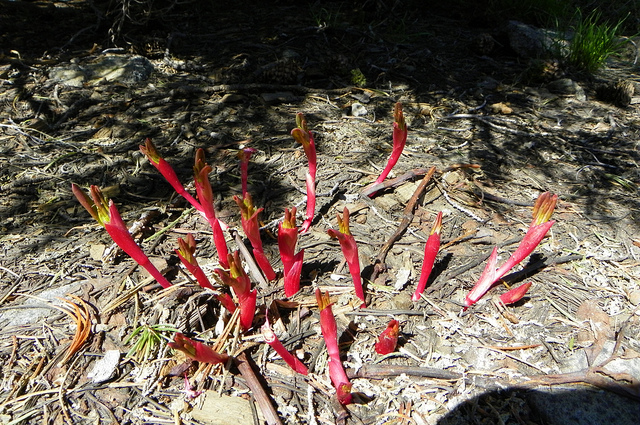Forums:
I photographed these new shoots emerging at the base of a clump of Whitebark pine(Pinus albicaulis). The location is Alpine County, CA, USA. On the trail from Carson Pass to Winnemucca Lake. We had just passed Frog Lake the elevation was in the region of 8600' (2 621m). I feel it may be a hemiparasitic species due to it's late emergence. This plant was just emerging in late July.
The bright red caught my eye right away.
The second shot is of a sprout that is in leaf and bud.



Comments
Lori S. (not verified)
Re: Bright red sprouts! Is this a hemiparasitic species ??
Mon, 11/15/2010 - 6:06pmIt puts me in mind of Asclepias... the leaf venation, particularly. I can't tell definitively from the photos if the leaves are opposite or not... but I get the sense that they are opposite... ?
Trond Hoy
Re: Bright red sprouts! Is this a hemiparasitic species ??
Tue, 11/16/2010 - 12:28pmWeiser, your plant looks like plants here when sprouting still covered by snow. When the snow cover melts the shoots have exactly this red and yellow color. Maybe a late melted heap of snow there?
I do not think it is a hemiparasitic plant though, but I can't swear on it.
Richard T. Rodich
Re: Bright red sprouts! Is this a hemiparasitic species ??
Tue, 11/16/2010 - 3:51pmBut the flower buds don't seem to be arranged in umbels...
Lori S. (not verified)
Re: Bright red sprouts! Is this a hemiparasitic species ??
Tue, 11/16/2010 - 6:19pmOkay. Hmmm, Apocynum, was my next guess... but those sheathed emerging stems are curious and I don't think they fit with dogbane.
John P. Weiser
Re: Bright red sprouts! Is this a hemiparasitic species ??
Tue, 11/16/2010 - 8:18pmThank you all for taking a stab at this. I wish I had picked a leaf to see if it had milky sap. With all the hiking I do I will probably run across this one again. I have a good freind who takes a lot of photos for the USDA Data Base, the Jepson Manual and Calflora I will see if he is willing to venture a guess. Again thank you all for your input.
John
John P. Weiser
Re: Bright red sprouts! Is this a hemiparasitic species ??
Thu, 11/18/2010 - 5:00pmLori, Hoy, Rick
I think I have an ID on this one! :) Polygonum davisiae
http://www.plant-materials.nrcs.usda.gov/pubs/orpmcot9936.pdf
http://ucjeps.berkeley.edu/cgi-bin/get_JM_treatment.pl?Polygonum+davisiae
http://www.calflora.org/cgi-bin/species_query.cgi?where-calrecnum=6747
http://www.flickr.com/photos/found-behind-the-ranges-over-yonder/219573474/
http://calphotos.berkeley.edu/cgi/img_query?where-genre=Plant&where-taxo...
(note: pay special attention to the second to last photo on the Calphoto link as it shows the red sprouts emerging)
Mark McDonough
Re: Bright red sprouts! Is this a hemiparasitic species ??
Thu, 11/18/2010 - 8:14pmOh man, I was chasing this down myself, I love a good mystery, and was exploring both Polygonum and Rumex, and believe it or not Paeonia californica (based on John's 1st photo, but the second photo shows more developed leaves which told me it wasn't that, but one starts imagining things when doing these ID puzzles).
Great detective work John! The next to last Calphoto showing the sprouts of Polygonum davisiae nails the ID.
Trond Hoy
Re: Bright red sprouts! Is this a hemiparasitic species ??
Fri, 11/19/2010 - 8:43amYes, Polygonum make sense. I do not know the American species but it reminds me of those growing here. The commonest is P. viviparum (syn. Bistorta vivipara) with edible rhizomes and bulblets.